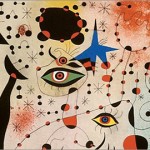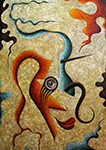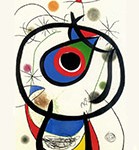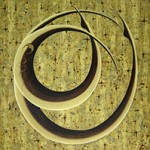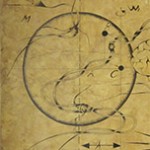Expressionism in the Work of Serap Kökten
Prof. Reem Hassan
The Theory of Expressionism
Anyone interested in art believes that the creativity process starts from the artist expressing his emotions towards the world. Without these emotions, art would not exist. These are the non-debatable facts, however, what raises controversy is: to what extent does the artwork depend on emotion? what is its nature? And if we try to analyse such emotions, shall we attribute them to a self-centered personality or to one that is connected to the surrounding reality with its objective relations. The ability to answer such questions lies in understanding the difference between the theory of expressionism and the other theories that followed in the history of art philosophy.
In his book “The Two Sources of Morality and Religion”, French philosopher Henri Bergson stresses that emotion is an art foundation and is the essence of creativity. He explains by clarifying the difference between a shake on the surface and an earthquake in depths. In the first case, the effect fades, as the parts shake without moving. However, in the second case, the effect lasts, and everything moves forward.
Therefore, art does not only express external realities, it also depicts an internal reality represented in a group of individual emotions that forces the artist to express them and transform them from an internal to an external existence, which is the tangible artwork.
Connecting Expressionism with Art Experiences
In his book “Art as Experience”, John Dewey says: “There are other works that are overloaded with emotion. On the theory that manifestation of an emotion is its expression, there could be no overloading; the more intense the emotion, the more effective the expression.”
The works of Kökten carry the spontaneous features of a light colorful theme manifested in several abstract models with an expressive template. They carry the meanings and values that show the artists’ experience in understanding contemporary design dimensions that fall into expressive molds and interact in various degrees and levels. Some of them dive into the human self to express many situations; others converse with the surface of things, as if they were completely external to the visual memory of the known artistic molds. They might also be stemming from the conscious self of the soul present during executing the artwork.
Kökten is a famous contemporary painter in the contemporary art scene in Istanbul. She works in the field of contemporary painting and her work is displayed in several multi-media sources. She works in the field of video art and installation arts, in addition to painting. The first stage of her work integrates personification and abstraction in one harmonious mold.
The stages of her later work, especially from 2011 until now, is much closer to abstract expressionism and is also inspired by the motifs of the primary schools of modern art as seen in the works of the prominent artist Joan Miró, as we can observe the inspiration and visual harmony in their works manifested in the blue color.
Comparing the works of the two artists to understand how Kökten is inspired by Miró, we realise that there are no seperative limits in their works, especially in using the motifs of the eyes and the organic lines. İn addition, the degrees of colours used in the background of their works are similar. They used red and a cold colour which is blue. It is used in both works with the same toning to create a great harmonious vision.
Joan Miro, Ciphers and Constellations in Love with a Women,1941
Serap Kökten, Nietzsche and dream wife Lou Salome, 2012
The two works below also express the abstract vision in Kökten’s work and its correlation with Miró’s single-element vision.
Joan Miro, Galathée, 1976 Serap Kökten, Half of the way, 2012
We can observe how the single element is selected in the painted design. In addition to the strong attempt to express the meditating face in a new vision by repeating the eye movement and centering it in the upper half of the painting, in addition to the concentration on the movement of the iris which symbolizes an internal psychological effect that strongly expresses the human shape. We can also see how it can be altered to bear many expressions and different ways of shaping the face and painting it in non-realistic forms expresses the gestures of the human face.
We can also find the use of circle shapes in both works. They are shown in Kökten’s work in the round face, in addition to organic shapes painted outside the features of the face (spiral shapes). Miró’s work shows organic shapes and lines outside the human shape. In both cases, it expresses excessive toning, as if they both decided to create a visual musical tune as they felt an obligation to include the spiral shapes to calm the design’s background.
Abstraction and its Aesthetics in the Works of Serap Kökten
Since abstraction is a fine work of art, the intensity of abstract expression, its content, and ability to move the spectator, they all depend on the artist’s inspiration of artistic experience from its sources, and simplifying it to its basics, while working on refining artistic formation and visual image, so that spectators can interact with it.
Abstraction is very diverse and gives artists plenty of styles. However, it focuses on the essence of things and briefly expressing them depending on the experiences that affected the artists. Abstraction can turn houses into rectangles, tree leaves can be oval, and a ball can be a circle. When the artistic experience is referred to its geometrical equivalent, its value depends on the experience of the artist.
The depth of the artists’ experience is what drives him to create either a simple shape, or a part that expresses the whole. A circle can be a ball, a sun, an orange, or simply a circle. However, artists wondered: is it better to transform the sun to a circle, or the circle to a sun? Should the artist rather transform the sun into a feeling equivalent to a round body? It could be the sun, the earth, a balloon or an apple!
One shape can suggest many others. Therefore, it becomes richer, such as the works of Paul Klee and Joan Miró.
One of the magnificent abstract works of Serap Kökten is a recent collection which strongly simulates the concept of the works of abstract school, such as the following works:
Serap Kökten, Çintemani-2012, Dance-2013, Imagination – Albert Einstein-2013,
Serap Kökten and Nature-Inspired Abstract Art
In abstract Art Inspired by Nature, artists try to express the essence of their experiences. When Picasso drew the body of the ox several times, his drawing progressed from the natural shape and features to expressing a number of lines that doesn’t match the animal in its external shape, but they still bear the structure and main frame with its moves, horns, and giant body. The final lines became abstracts of the idea of the ox.
Nature-inspired individual abstract art expresses a development from sensory to complete perception. However, it was also noticed that this abstraction is fulfilled through successive generations of artists. Every generation discovers a shape, another generation uses it, and the shape rotates and moves from one generation to another.
The balance of flexible forms (organic shapes) in Serap Kökten’s work shown through the surface of her artworks is divided into central and illusory balance. The central balance is best expressed through the human body. However, the abstract colour form is always expressed through the central or illusory balance, as shown in the works displayed here.
The central balance is achieved through several elements that have the shape of painted blocks in the artwork. This radiative balance also gives us a great deal of balance, especially in the main painted design, as there is partial likeness connected to the structure. Since we considered the radiative balance a movement that surrounds a central point that is crucial to the design, then the works of Serap Kökten is a perfect example of the works of abstract art school
Serap Kökten expresses the contemporary painting scene in istanbul through her abstract expression painting works.
Prof. Reem Hassan
March 2015

